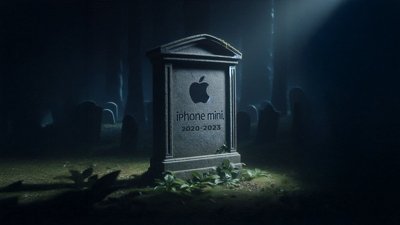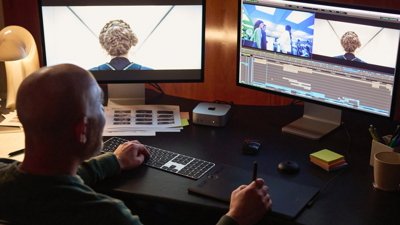Identifying the problem
Clear observations of mobile signal strength and how they are affected by the placement of users' hands are difficult to perform in part because there are multiple factors involved in receiving a mobile radio link, including outside interference and the conductivity or mass of different people's hands.
Additionally, cellphones in general (and in particular the iPhone) have always only presented a very rough approximation of signal strength in the signal bar display, averaged over time. It appears that iOS 4, more so than previous iPhone software, presents a less accurate signal meter, showing less signal at times than an iPhone 3GS while still being able to achieve the same or better call quality.
This has led some to jump to the conclusion that the reception problems noted by some iPhone 4 users are the sign of a hardware design flaw related to its stainless steel band antenna design. Apple's chief executive Steve Jobs stoked a whiplash of blogger frenzy when he reportedly responded that users "were holding it the wrong way," blocking the signal with their hands.
A variety of people have demonstrated identical problems with other phones, from the Android based Nexus One to the iPhone 3GS. Yesterday, my wry tweet, "Blocking iPhone 4 antenna kills reception. Blocking mic kills audio, and covering the screen makes it impossible to see Retina Display" made it to the front page of Twitter and was retweeted more than a hundred times by people following the hullabaloo.
However, the fact that problems observed in the iPhone 3GS are much more pronounced when the device is upgraded to iOS 4 indicate that there is also a software issue involved in the matter. iPhone 4 users can't downgrade to earlier versions of the core software, making it impossible to compare its relative performance.
Software fix in the works
Readers report that Apple's tech support forums originally confirmed that a iOS 4.0.1 software fix addressing the issue would ship early next week (as early as Monday), before the comments were subsequently taken down along with all the other related discussion about the matter.
The fix is expected to address a issue in iOS 4 related to radio frequency calibration of the baseband. Readers who saw the original forum discussions say that the issue is believed to occur when switching frequencies; because the lag is allegedly not calibrated correctly, it results in the device reporting "no service" rather than switching to the frequency with the best signal to noise ratio.
iOS 4 introduced some enhancements to how the baseband selects which frequencies to use, so it makes sense that the error may have crept into those changes. Additionally, this explains why iOS 4 has also caused similar problems for iPhone 3GS users.
Additional readers have shared other related experiences that also corroborate the idea that the issue is related to iOS 4's software control of the baseband, including the fact that the issue seems easily reproducible when connecting to a WWAN 3G network but does not appear when connecting to a Microcell 3G. If the problem were simply hardware related issues of the antenna design, it should only affect iPhone 4 units with that new design and should occur at all times, regardless of the tower type. That is not being observed.
Talk to the hand
The core software problem is likely augmented by hand placement, as Jobs noted in pointing out that holding the new phone (or any mobile device) in such a way that attenuates the signal should simply be avoided.
Yesterday, antenna design expert Spencer Webb posted his early appraisal of the situation, noting that the FCC mandates that cell phone antennas need to be positioned as far away from the user's head as possible, effectively forcing antenna placement in the bottom of the phone, where it is most likely to be covered by the user's hand.
Webb also noted that neither the regulatory tests performed by the FCC during its approval process, nor the antenna efficiency tests performed by the carrier (AT&T) during its own device requirements testing take into account how a user's hand might play into the antenna design and the test results.
The bottom-mounted antenna design "evolved to meet [FCC] requirements," Webb explained. "And efficient transmission and reception while being held by a human hand are simply not design requirements!"
Webb points out that Bluetooth headsets also suffer from attenuation when the phone is positioned in such a way that the user's body absorbs too much of the signal. He assumed that the iPhone 4 design, which "moved the antenna action from the back of the phone to the sides," will likely only improve things when the phone is "suspended magically in air," but may actually make things worse when the phone is placed in the user's pocket.
At the same time, Webb says he voted with his dollars to buy the new iPhone 4 anyway, adding, "sometimes an antenna that's not great, but good enough, is good enough."
 Daniel Eran Dilger
Daniel Eran Dilger






-m.jpg)






 Christine McKee
Christine McKee
 Wesley Hilliard
Wesley Hilliard
 Thomas Sibilly
Thomas Sibilly
 Marko Zivkovic
Marko Zivkovic
 Andrew O'Hara
Andrew O'Hara
 Amber Neely
Amber Neely
 William Gallagher
William Gallagher









613 Comments
No bar drop after 2 full recharges!
I've done 2 full battery recharges and the bar drop all but disappeared. It was noticeable during the first day, less so after the first recharge, and now I've been squeezing the heck out of the phone for 30 min straight and it stubbornly stays at 5 bars.
Could it be that the whole thing is a combination of software/power management, and a conditioned battery responding much better to the changes in the antenna load? Notice, that all the negative responses appeared during the first day of use.
Loss of reception while dialing out?
Avoid using the phone for phone calls.
Dropped calls in San Francisco?
Avoid going to San Francisco.
Playhouse Disney (or other flash site) doesn't work in the browser?
Avoid going to that site.
Screen gets smudged?
Avoid touching the screen.
Hate getting ripped off for expensive junk?
Stop buying Apple products.Seriously, if the software fix doesn't do it, there will be multitudes of ripped off users who will be pissed off.
This really is a pattern: Apple releases something new, there is a big hype, and then people get all hysteric about something not properly working. A couple of days or at most weeks later, no one really talks about it any more and it seems people just overreacted. This thing is out for just two days- if you are an early adopter, give this thing some time in the wild, and also think about how many people do NOT have problems. As long as that's the vast majority - there is no real problem.
Loss of reception while dialing out?
Avoid using the phone for phone calls.
Dropped calls in San Francisco?
Avoid going to San Francisco.
Playhouse Disney (or other flash site) doesn't work in the browser?
Avoid going to that site.
Screen gets smudged?
Avoid touching the screen.
Hate getting ripped off for expensive junk?
Stop buying Apple products.Seriously, if the software fix doesn't do it, there will be multitudes of ripped off users who will be pissed off.
I thought USA is a free country, where people do what they want!
Does this happens outside USA?
Apple techs will be busting their nuts working on this one this weekend, lol. I'm sure they'll figure something out somehow. Just get it done before we get it (god knows when) in Canada
Oh, I heard that sitting on your phone decreases the bars to zero, great!!